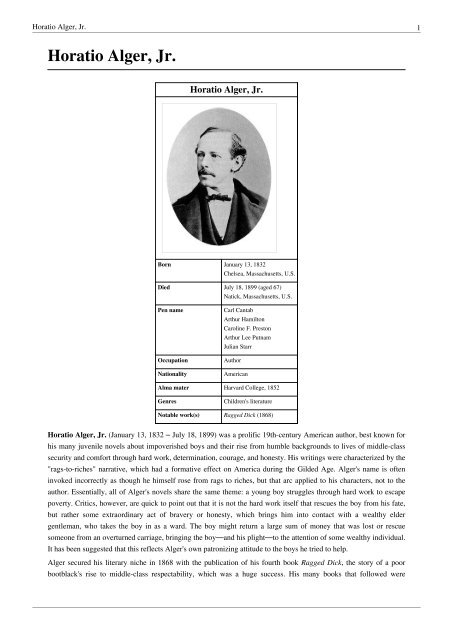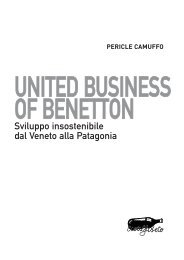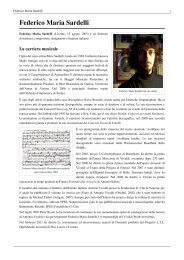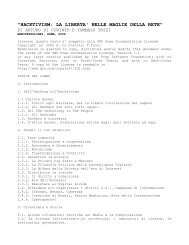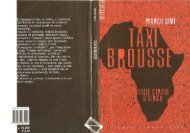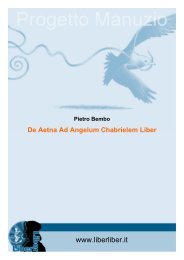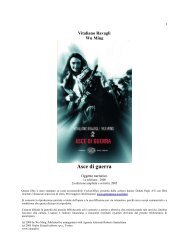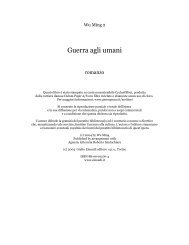Horatio Alger, Jr. - Classici Stranieri
Horatio Alger, Jr. - Classici Stranieri
Horatio Alger, Jr. - Classici Stranieri
You also want an ePaper? Increase the reach of your titles
YUMPU automatically turns print PDFs into web optimized ePapers that Google loves.
<strong>Horatio</strong> <strong>Alger</strong>, <strong>Jr</strong>. 1<strong>Horatio</strong> <strong>Alger</strong>, <strong>Jr</strong>.<strong>Horatio</strong> <strong>Alger</strong>, <strong>Jr</strong>.Born January 13, 1832Chelsea, Massachusetts, U.S.Died July 18, 1899 (aged 67)Natick, Massachusetts, U.S.Pen nameOccupationNationalityCarl CantabArthur HamiltonCaroline F. PrestonArthur Lee PutnamJulian StarrAuthorAmericanAlma mater Harvard College, 1852GenresChildren's literatureNotable work(s) Ragged Dick (1868)<strong>Horatio</strong> <strong>Alger</strong>, <strong>Jr</strong>. (January 13, 1832 – July 18, 1899) was a prolific 19th-century American author, best known forhis many juvenile novels about impoverished boys and their rise from humble backgrounds to lives of middle-classsecurity and comfort through hard work, determination, courage, and honesty. His writings were characterized by the"rags-to-riches" narrative, which had a formative effect on America during the Gilded Age. <strong>Alger</strong>'s name is ofteninvoked incorrectly as though he himself rose from rags to riches, but that arc applied to his characters, not to theauthor. Essentially, all of <strong>Alger</strong>'s novels share the same theme: a young boy struggles through hard work to escapepoverty. Critics, however, are quick to point out that it is not the hard work itself that rescues the boy from his fate,but rather some extraordinary act of bravery or honesty, which brings him into contact with a wealthy eldergentleman, who takes the boy in as a ward. The boy might return a large sum of money that was lost or rescuesomeone from an overturned carriage, bringing the boy—and his plight—to the attention of some wealthy individual.It has been suggested that this reflects <strong>Alger</strong>'s own patronizing attitude to the boys he tried to help.<strong>Alger</strong> secured his literary niche in 1868 with the publication of his fourth book Ragged Dick, the story of a poorbootblack's rise to middle-class respectability, which was a huge success. His many books that followed were
<strong>Horatio</strong> <strong>Alger</strong>, <strong>Jr</strong>. 2essentially variations on Ragged Dick and featured a cast of stock characters: the valiant hard-working, honest youth(who knew more Latin than the villain), the noble, mysterious stranger (whom the poor boy rescued and by whom hegot rewarded), the snobbish youth (cousin), and the evil squire (uncle).In the 1870s, <strong>Alger</strong> took a trip to California to gather material for future books, but the trip had little influence on hiswriting. In the last decades of the 19th century, boys' tastes changed, and <strong>Alger</strong>'s moral tone coarsened accordingly.The Puritan ethic had loosened its grip on America, and violence, murder, and other sensational themes entered<strong>Alger</strong>'s works. Public librarians questioned whether his books should be made available to the young. By the time hedied in 1899, he had published around a hundred volumes.BiographyChildhood: 1832–1847<strong>Horatio</strong> <strong>Alger</strong>, <strong>Jr</strong>. was born in the New England coastal town of Chelsea, Massachusetts, on January 13, 1832, to<strong>Horatio</strong> <strong>Alger</strong>, a Unitarian minister, and his wife Olive Augusta Fenno. [1][2] He was the descendant of PlymouthPilgrims Robert Cushman, Thomas Cushman, William Bassett, and the descendant of Sylvanus Lazell, a Minutemanand brigadier general in the War of 1812; and Edmund Lazell, a member of the Constitutional Convention in 1788. [3]<strong>Horatio</strong>'s siblings Olive Augusta and James were born in 1833 and 1836, and an invalid sister Annie and a brotherFrancis in 1840 and 1842. [4] <strong>Alger</strong> was a precocious boy afflicted with nearsightedness and bronchial asthma, [5][6]but <strong>Alger</strong>, Sr. decided early that his eldest son would one day enter the ministry, and, to that end, he tutored the boyin classical studies and allowed him to observe the responsibilities of ministering to parishioners. [7] <strong>Alger</strong> beganattending the Chelsea Grammar School in 1842, [8] but by December 1844 his father's financial troubles hadincreased considerably and, in search of a better salary, he moved his family to Marlborough, Massachusetts, anagricultural town 25 miles west of Boston. He was installed as pastor of the Second Congregational Society inJanuary 1845 with a salary sufficient to meet his needs. [9] <strong>Horatio</strong> attended Gates Academy, a local preparatoryschool, and completed his studies at age fifteen. He published his earliest literary work in local newspapers. []Harvard and early works: 1848–1864In July 1848 <strong>Alger</strong> passed the Harvard entrance examinations, and was admitted to the class of 1852. Thefourteen-member full-time Harvard faculty included Louis Agassiz and Asa Gray (sciences), Cornelius ConwayFelton (classics), James Walker (religion and philosophy), and Henry Wadsworth Longfellow (belles lettres).Edward Everett served as president. <strong>Alger</strong>'s classmate Joseph Choate described Harvard at this time as "provincialand local because its scope and outlook hardly extended beyond the boundaries of New England; besides which itwas very denominational, being held exclusively in the hands of Unitarians". []
<strong>Horatio</strong> <strong>Alger</strong>, <strong>Jr</strong>. 3<strong>Alger</strong>, July 1852<strong>Alger</strong> flowered in the highly disciplined and regimented Harvardenvironment, winning scholastic prizes and prestigious awards. [10] Hisgenteel poverty and less-than-aristocratic heritage however barred himfrom membership in the Hasty Pudding and Porcellian clubs. [11] In1849 he became a professional writer when he sold two essays and apoem to the Pictorial National Library, a Boston magazine. [12] Hebegan reading Sir Walter Scott, James Fenimore Cooper, HermanMelville, and other modern writers of fiction and cultivated a lifelonglove for Longfellow, whose verse he sometimes employed as a modelfor his own. He was chosen Class Odist, and graduated with Phi BetaKappa honors in 1852, eighth in a class of 88. [13]<strong>Alger</strong> had no job prospects following graduation and returned home.He continued to write, submitting his work to religious and literarymagazines with varying success. [14] He briefly attended HarvardDivinity School in 1853, possibly to be reunited with a romanticinterest, [15] but left in November 1853 to take a job as an assistanteditor with the Boston Daily Advertiser. [16] He loathed editing and quit in 1854 to teach at The Grange, a boys'boarding school in Rhode Island. When The Grange suspended operations in 1856, <strong>Alger</strong> found employmentmanaging the 1856 summer session at Deerfield Academy. [17][18] His poems at this time expressed a sexualambivalence, and were sometimes written in a woman's voice.His first book, a collection of short pieces called Bertha's Christmas Vision: An Autumn Sheaf, was published in1856, and his second, a lengthy satirical poem called Nothing to Do: A Tilt at our Best Society, was published in1857. [19] He attended the Harvard Divinity School from 1857 to 1860, and upon graduation, he did a tour ofEurope. [20] In the spring of 1861, he returned to a nation in the throes of the Civil War. [21] Drafted but exemptedfrom military service in July 1863, he wrote in support of the Union cause and hobnobbed with New Englandintellectuals. He was elected an officer in the New England Genealogical Society in 1863. [22]His first novel Marie Bertrand: The Felon's Daughter was serialized in the New York Weekly in 1864, and his firstboys' book Frank's Campaign was published by A. K. Loring in Boston the same year. [23] <strong>Alger</strong> initially wrote foradult magazines, including Harper's Monthly and Frank Leslie's Illustrated Newspaper; a friendship with WilliamTaylor Adams, a boys' author, led him to write for the young. [24]Ministry: 1864–1866On December 8, 1864 <strong>Alger</strong> was installed as pastor with the First Unitarian Church and Society of Brewster,Massachusetts. [25] Between ministerial duties, he organized games and amusements for the boys in the parish, railedagainst smoking and drinking, and organized and served as president of the local chapter of the Cadets forTemperance. [26][27] He submitted stories to Student and Schoolmate, a boys' monthly magazine of moral writingsedited by William Taylor Adams (Oliver Optic) and published in Boston by Joseph H. Allen. [28] In September 1865his second boys' book Paul Prescott's Charge was published to favorable reviews. [29][30]Early in 1866, a church committee was formed to investigate sexual misconduct reports about <strong>Alger</strong>. He deniednothing, admitted he had been imprudent, considered his association with the church dissolved, and left town.Church officials reported to the hierarchy in Boston that <strong>Alger</strong> had been charged with "the crime of...unnaturalfamiliarity with boys". [31][32] <strong>Alger</strong> sent Unitarian officials in Boston a letter of remorse, and his father assured themhis son would never seek another post in the church. Officials were satisfied and decided no further action would betaken. [33]
<strong>Horatio</strong> <strong>Alger</strong>, <strong>Jr</strong>. 4New York City: 1866–1896<strong>Alger</strong> relocated to New York City, abandoned forever any thought of acareer in the church, and focused instead on his writing. He wrote"Friar Anselmo" at this time, a poem that tells of a sinning cleric'satonement through good deeds. He became interested in the welfare ofthe thousands of vagrant children who flooded New York Cityfollowing the Civil War. He attended a children's church service atFive Points which led to "John Maynard", a ballad about an actualshipwreck on Lake Erie that brought <strong>Alger</strong> not only the respect of theliterati but a letter from Longfellow. He published two poorly receivedadult novels, Helen Ford and Timothy Crump's Ward. He fared betterwith stories for boys published in Student and Schoolmate and a thirdboys' book Charlie Codman's Cruise. [34]In January 1867 the first of twelve installments of Ragged Dickappeared in Student and Schoolmate. The story about a poorbootblack's rise to middle class respectability was a huge success. Itwas expanded, and published as a novel in 1868. [35] It proved to be hisbestseller. After Ragged Dick he wrote almost entirely for boys, [36] andsigned a contract with publisher Loring for a Ragged Dick Series. [37]William Taylor Adams, editor of Student andSchoolmateRagged Dick was serialized in Student andSchoolmateIn spite of the series' success, <strong>Alger</strong> was on financially uncertainground and tutored the five sons of international banker JosephSeligman. He wrote serials for Young Israel, [38] and lived in theSeligman home until 1876. [39] In 1875 <strong>Alger</strong> produced the serialShifting for Himself and Sam's Chance, a sequel to The YoungOutlaw. [40] It was evident in these that <strong>Alger</strong> had grown stale. Profitssuffered, and he headed West for new material at Loring's behest,arriving in California in February 1877. [41] He enjoyed a reunion withhis brother James in San Francisco and returned to New York late in1877 via a schooner around Cape Horn. [42] He wrote a few lacklusterbooks in the following years that rehashed the formulaic <strong>Alger</strong> of oldbut this time the tales were played before a Western backcloth ratherthan an urban one. [43]In New York, <strong>Alger</strong> continued to tutor the town's aristocratic youth andto rehabilitate its street boys. [44] He was writing both urban andWestern-themed tales. In 1879, for example, he published The DistrictMessenger Boy and The Young Miner. [45] In 1877, <strong>Alger</strong>'s fictionbecame a target of librarians concerned about sensational juvenilefiction. An effort was made to remove <strong>Alger</strong>'s works from publiccollections, but the debate was only partially successful, defeated by the renewed interest in <strong>Alger</strong>'s work after hisdeath. [46]In 1881, <strong>Alger</strong> informally adopted Charlie Davis, a street boy, and another, John Downie, in 1883; they lived in<strong>Alger</strong>'s apartment. In 1881, he wrote President James A. Garfield's biography, but filled the work with contrivedconversations and boyish excitements rather than facts. The book sold well. <strong>Alger</strong> was commissioned to giveAbraham Lincoln a biographical treatment but again it was <strong>Alger</strong> the boys' novelist opting for thrills rather thanfacts. [47]
<strong>Horatio</strong> <strong>Alger</strong>, <strong>Jr</strong>. 5In 1882, <strong>Alger</strong>'s father died. <strong>Alger</strong> continued to produce stories of honest boys outwitting evil, greedy squires, andmalicious youths. His work appeared in hardcover and paperback, and decades-old poems were published inanthologies. He led a busy life with the street boys, his Harvard classmates, and the social elite. In Massachusetts, hewas regarded with the same reverence as Harriet Beecher Stowe. He tutored with never a whisper of scandal.Last years: 1896–1899In the last two decades of the 19th century, the quality of <strong>Alger</strong>'s booksdeteriorated and his boys' works became nothing more than reruns ofthe plots and themes of his past. [48] The times had changed, boysexpected more, and a streak of violence entered <strong>Alger</strong>'s work. In TheYoung Bank Messenger, for example, a woman is throttled andthreatened with death—an episode that would never have occurred inhis earlier work. [49]He attended the theater and Harvard reunions, read the literarymagazines, and wrote a poem at Longfellow's death in 1892. His lastnovel for adults, The Disagreeable Woman, was published under thepseudonym Julian Starr. [] He took pleasure in the successes of the boyshe had informally adopted over the years, retained his interest inreform, accepted speaking engagements, and read portions of RaggedDick to boys' assemblies.His popularity—and income—dwindled in the 1890s. In 1896, he had(what he called) a "nervous breakdown"; he relocated permanently tohis sister's home in South Natick, Massachusetts. [] After suffering frombronchitis and asthma for two years, he died on July 18, 1899. [50] Hisdeath was barely noticed.Before his death, <strong>Alger</strong> asked Edward Stratemeyer to complete hisunfinished works. [] In 1901, Young Captain Jack was completed by<strong>Alger</strong> gravestone, Natick, MassachusettsStratemeyer and promoted as <strong>Alger</strong>'s last work. <strong>Alger</strong> once estimated that he earned only $100,000 between 1866and 1896; [] at his death he had little money, leaving only small sums to family and friends. His literary work wasbequeathed to his niece, to two boys he had casually adopted, and to his sister Olive Augusta, who destroyed hismanuscripts and his letters at his wish. [51]<strong>Alger</strong>'s works received favorable comments and experienced a resurgence following his death; up until the advent ofthe Jazz Age in the 1920s, he sold about seventeen to twenty million volumes. In 1926, however, reader interestplummeted and his major publisher ceased printing the books altogether. Surveys in 1932 and 1947 revealed veryfew children had read or even heard of <strong>Alger</strong>. The first <strong>Alger</strong> biography was a heavily fictionalized accountpublished in 1928 by Herbert R. Mayes, who later admitted the work was a fraud. [52][53]
<strong>Horatio</strong> <strong>Alger</strong>, <strong>Jr</strong>. 6LegacySince 1947, the <strong>Horatio</strong> <strong>Alger</strong> Association of Distinguished Americans has bestowed an annual award on"outstanding individuals in our society who have succeeded in the face of adversity" and scholarships "to encourageyoung people to pursue their dreams with determination and perseverance".A 1982 musical, Shine!, was based on <strong>Alger</strong>'s work, particularly Ragged Dick and Silas Snobden's Office Boy. [54]Style and themes<strong>Alger</strong> scholar Gary Scharnhorst describes <strong>Alger</strong>'s style as"anachronistic", "often laughable", "distinctive", and "distinguished bythe quality of its literary allusions". Ranging from the Bible andShakespeare (half of <strong>Alger</strong>'s books contain Shakespearean references)to John Milton and Cicero, the allusions he employed were a testamentto his erudition. Scharnhorst credits these allusions for distinguishing<strong>Alger</strong>'s novels from pulp fiction. [55]Scharnhorst describes six major themes in <strong>Alger</strong>'s boys' books. Thefirst, the Rise to Respectability, he observes, is evident in both his earlyand late books, notably in Ragged Dick, whose young impoverishedhero declares: "I mean to turn over a new leaf, and try to grow up'spectable." His virtuous life wins him—not riches—but, morerealistically, a comfortable clerical position and salary. [56] The secondmajor theme explores Character Strengthened Through Adversity. InStrong and Steady and Shifting for Himself, for example, the affluentheroes are reduced to poverty and forced to meet the demands of theirnew circumstances. <strong>Alger</strong> occasionally cited the young Abe Lincoln asa representative of this theme for his readers. The third theme is Beautyversus Money, which became central to <strong>Alger</strong>'s adult fiction.Cover of Chester Rand by <strong>Alger</strong>Characters fall in love and marry based on the their character, talents, or intellect rather than the size of their bankaccounts. In The Train Boy, for example, a wealthy heiress chooses to marry a talented but struggling artist and inThe Erie Train Boy a poor woman wins her true love despite the machinations of a rich, depraved suitor. [57]All of <strong>Alger</strong>'s novels rework the same plot: a young boy struggles to escape poverty through hard work and cleanliving. However, it is not always the hard work and clean living that rescue the boy from his situation, but rather awealthy older gentleman, who admires the boy as a result of some extraordinary act of bravery or honesty that theboy has performed. For example, the boy might rescue a child from an overturned carriage or find and return theman's stolen watch. Often the older man takes the boy into his home as a ward or companion and helps him find abetter job (sometimes replacing a less honest or industrious boy).According to Scharnhorst, <strong>Alger</strong>'s father was "an impoverished man" who defaulted on his debts in 1844. Hisproperties around Chelsea were seized and assigned to a local squire who held the mortgages. Scharnhorst speculatesthis episode in <strong>Alger</strong>'s childhood accounts for the recurrent theme in his boys' books of heroes being threatened witheviction or foreclosure, and may account for <strong>Alger</strong>'s "consistent espousal of environmental reform proposals".Scharnhorst writes "Financially insecure throughout his life, the younger <strong>Alger</strong> may have been active in reformorganizations such as those for temperance and children's aid as a means of resolving his status-anxiety and establishhis genteel credentials for leadership." [58]<strong>Alger</strong> scholar Hoyt notes that <strong>Alger</strong>'s morality "coarsened" around 1880, possibly influenced by the Western tales hewas writing, because "the most dreadful things were now almost casually proposed and explored". Although hecontinued to write for boys, <strong>Alger</strong> explored subjects like violence and "openness in the relations between the sexes
<strong>Horatio</strong> <strong>Alger</strong>, <strong>Jr</strong>. 9John Maynard: A Ballad ofLake Erie1868 Poem. Published in Student andSchoolmate in January 1868 andthen in various publications.A helmsman perishes at the wheel while the shipburns. Based on an actual incident.Ragged Dick; or, Street Life inNew York with the Bootblacks1868 JuvenileNovel.First serialized in twelveinstallments in Student andSchoolmate in 1867. Published byLoring in book format in 1868.First volume of the Ragged Dick Series. A New YorkCity bootblack rises to middle class respectabilitythrough hard work, honesty, and determination.<strong>Alger</strong>'s all-time bestseller. Online at Gutenberg [67]Fame and Fortune; or, TheProgress of Richard Hunter1868 JuvenileNovel.First serialized in twelveinstallments in Student andSchoolmate. Novelizationpublished by Loring.Second volume of the Ragged Dick Series. Continuesthe story of Ragged Dick and his experiences afterleaving bootblacking for an office job. Online atGutenberg [68] .Struggling Upward; or, LukeLarkin's Luck1868 JuvenileNovel.Published by Loring.Small town boy helps solve bank robbery. Online atGutenberg [69]Luck and Pluck; or, JohnOakley's Inheritance1869 JuvenileNovel.Published by Loring.First volume in the Luck and Pluck Series.Mark the Match Boy; or,Richard Hunter's Ward1869 JuvenileNovel.Published by Loring.Third volume in the Ragged Dick Series.Rough and Ready; or, LifeAmong the New York Newsboys1869 JuvenileNovel.Published by Loring.Fourth volume in the Ragged Dick Series.Ralph Raymond's Heir; or, TheMerchant's Crime1869 Short Story. Published under the pseudonym"Arthur Hamilton" for Gleason'sLiterary Companion.Ben The Luggage Boy; or,Among the Wharves1870 JuvenileNovel.Published by Loring.Fifth volume in the Ragged Dick Series. Boy runsaway from home and struggles as a luggage carrier inNew York. Online at Gutenberg [70] .Rufus and Rose; or, TheFortunes of Rough and Ready1870 JuvenileNovel.Published by Loring.Sixth and final volume in the Ragged Dick Series.Sequel to Rough and Ready. Rufus and Rose try toavoid their evil stepfather. Online at Gutenberg [71]Sink or Swim; or, HarryRaymond's Resolve1870 JuvenileNovel.Published by Loring.Second volume in the Luck and Pluck Series.Paul the Peddler; or theFortunes of a Young StreetMerchant1871 JuvenileNovel.Serialized in Student andSchoolmate. Novelizationpublished by Loring.Second volume in the Tattered Tom Series. Youngentrepreneur goes from selling candy to owning anecktie stand. Online at Gutenberg [72]Strong and Steady; or, PaddleYour Own Canoe1871 JuvenileNovel.Published by Loring.Third volume in the Luck and Pluck Series.Tattered Tom; or, The Story ofa Street Arab1871 JuvenileNovel.Published by Loring.First volume in the Tattered Tom Series. Jane Lindsayis a child streetsweeper."Friar Anselmo" 1872 Poem. A sinning cleric finds redemption in ministering to thesick.Phil the Fiddler; or, The Storyof a Young Street Musician1872 JuvenileNovel.Published by Loring.Third volume in the Tattered Tom Series. Phil is anItalian boy enslaved by a padrone.Slow and Sure; The Story ofPaul Hoffman the YoungStreet-Merchant1872 JuvenileNovel.Published by Loring.Fourth volume in the Tattered Tom Series. Sequel toPaul the Peddler. Paul moves from his street stall to aretail store. Online at Gutenberg [73]Strive and Succeed; or, TheProgress of Walter Conrad1872 JuvenileNovel.Published by Loring.Fourth volume in the Luck and Pluck Series. Online atUniversity of Florida [74]
<strong>Horatio</strong> <strong>Alger</strong>, <strong>Jr</strong>. 10Bound to Rise; or, Up theLadder1873 JuvenileNovel.Published by Loring.Seventh volume in the Luck and Pluck Series.Try and Trust; or, The Story ofa Bound Boy1873 JuvenileNovel.Published by Loring.Fifth volume in the Luck and Pluck Series.Brave and Bold; or, TheFortunes of Robert Rushton1874 JuvenileNovel.Published by Loring.First in the Brave and Bold Series. A youth searchesfor his sea captain father.Julius; or, The Street Boy OutWest1874 JuvenileNovel.Published by Loring.Fifth volume in the Tattered Tom Series. A boy isresettled in the west through the agency of theChildren's Aid Society.Risen from the Ranks; or,Harry Walton's Success1874 JuvenileNovel.Published by Loring.Sixth volume in the Luck and Pluck Series.Grand'ther Baldwin'sThanksgiving1875 Poems.Herbert Carter's Legacy; or,The Inventor's Son1875 JuvenileNovel.Published by Loring.Eighth and last volume in the Luck and Pluck Series.A boy and his mother thwart a Squire foreclosing ontheir cottage.Jack's Ward; or, The BoyGuardian1875 JuvenileNovel.Published by Loring.Second volume in the Brave and Bold Series.Reworking of Timothy Crump's Ward.Seeking His Fortune, AndOther Dialogues1875St. Nicholas 1875The Young Outlaw; or, AdriftIn The Streets1875 JuvenileNovel.Published by Loring.Sixth volume in the Tattered Tom Series. Sam Barlowresists reform.Sam's Chance; and How HeImproved It1876 JuvenileNovel.Published by Loring.Seventh volume in the Tattered Tom Series. Sequel toThe Young Outlaw. Sam improves and finds an officejob.Shifting for Himself; or, GilbertGreyson's Fortunes1876 JuvenileNovel.Published by Loring.Third volume in the Brave and Bold Series. A richyouth loses his fortune.Life of Edwin Forrest 1877 BiographyThe New Schoolma'am; or, ASummer in North Sparta1877 AdultNovella.Published anonymously.A privileged young woman changes her name to teachschool in New Hampshire.Wait and Hope; or, BenBradford's Motto1877 JuvenileNovel.Published by Loring.Fourth and last volume in the Brave and Bold Series.A mill boy is laid off but remains optimistic about hisfuture.The Western Boy; or, The Roadto Success1878The Young Adventurer; or,Tom's Trip Across the Plains1878 Juvenilenovel.Published by Loring.First volume of the Pacific series. Western setting. Aboy head west to find gold and help pay the mortgage.The Telegraph Boy 1879 JuvenileNovel.Published by Loring.Eighth and last volume in the Tattered Tom Series. Apenniless boy finds a job as a telegram messenger boy.Last of the fourteen social reform novels begun withRagged Dick. Online at University of Florida [75]The Young Miner; or, TomNelson in California1879 JuvenileNovel.Published by Loring.Western theme. Second volume of the Pacific series.Tony the Hero 1880The Young Explorer; or,Among the Sierras1880 Juvenilenovel.Published by Loring.Western theme. Third volume in the Pacific series
<strong>Horatio</strong> <strong>Alger</strong>, <strong>Jr</strong>. 11From Canal Boy to President;or, The Boyhood and Manhoodof James A. Garfield1881 Biography Published by John R. AndersonBen's Nugget; or, A Boy'sSearch for Fortune1882 Juvenilenovel.Published by Porter & Coatesafter Loring declares bankruptcy.Western theme. Fourth and final volume in the Pacificseries.From Farm Boy to Senator:Being the History of theBoyhood and Manhood ofDaniel WebsterAbraham Lincoln: theBackwoods Boy; or, How AYoung Rail-Splitter BecamePresident1882 Biography Published by J. S. Ogilvie andCompany.1883 Biography Published by John R. Anderson.Originally published in serialization by Street &Smith, 1860s.The Train Boy 1883The Young Circus Rider; or,The Mystery of Robert Rudd1883Dan, the Detective 1884Do and Dare; or A Brave Boy'sFight for FortuneHector's Inheritance; or, TheBoys of Smith InstituteHelping Himself; or, GrantThornton's Ambition188418851886Online at UFL [76]Frank Fowler, the Cash Boy 1887Number 91; or, The Adventuresof a New York Telegraph Boy1887The Store Boy; or, The1887Fortunes of Ben Barclay [77]Bob Burton; or, The YoungRanchman of the MissouriThe Errand Boy; or, How PhilBrent Won Success1888 Published by The WorldSyndicate Publishing Co.,Cleveland, O./NY, NY1888Tom Temple's Career 1888Tom Thatcher's Fortune 1888Tom Tracy 1888The Young Acrobat of theGreat North American CircusLuke Walton; or, The ChicagoNewsboy1888 Juvenile1889novel.Circus theme suggested by P. T. Barnum. Firstserialized in The Golden Argosy.The Erie Train Boy 1890Five Hundred Dollars; or,Jacob Marlowe's Secret1890Mark Stanton 1890Ned Newton; or, The Fortunesof a New York Bootblack1890 Juvenilenovel.First serialized in The Golden Argosy.
<strong>Horatio</strong> <strong>Alger</strong>, <strong>Jr</strong>. 12A New York Boy 1890The Odds Against Him; or,Carl Crawford's ExperienceDean Dunham; or, TheWaterford MysteryDigging for Gold. A Story ofCaliforniaThe Young Boatman of PinePoint1890189118921892Cast Upon the Breakers 1893Facing the World; or, TheHaps and Mishaps of HarryVaneIn a New World; or, Among theGold-Fields of AustraliaOnly an Irish Boy; Or, AndyBurke's Fortunes andMisfortunesVictor Vane, The YoungSecretaryThe Disagreeable Woman; ASocial Mystery18931893189418941895 Adult Novel G. W. Carleton <strong>Alger</strong>'s last adult novel. Only one copy is known andheld in the Library of Congress.Frank Hunter's Peril 1896The Young Salesman 1896Frank and Fearless; or, TheFortunes of Jasper Kent1897Walter Sherwood's Probation 1897A Boy's Fortune; or, TheStrange Adventures of BenBaker1898The Young Bank Messenger 1898Jed the Poorhouse Boy 1899 Juvenilenovel.Online at Gutenberg [78] .A poorhouse boy is discovered to be an Englishbaronet.Mark Mason's Victory; or, TheTrials and Triumphs of aTelegraph Boy1899Rupert's Ambition 1899Silas Snobden's Office Boy 1899 Doubleday Originally serialized by Argosy under the pseudonymArthur Lee Putnam.A Debt of Honor. The Story ofGerald Lane's Success in theFar WestFalling in With Fortune; or,The Experiences of a YoungSecretaryOut for Business; or, RobertFrost's Strange Career190019001900
<strong>Horatio</strong> <strong>Alger</strong>, <strong>Jr</strong>. 13Ben Bruce. Scenes in the Life ofa Bowery Newsboy1901Lester's Luck 1901Nelson the Newsboy; or, Afloatin New YorkTom Brace: Who He Was andHow He FaredYoung Captain Jack; or, TheSon of a SoldierAdrift in the City; or, OliverConrad's Plucky Fight190119011901 JuvenileNovel1902Originally serialized in Golden Hours. Promoted as<strong>Alger</strong>'s last work. Completed by Edward Stratemeyeras Arthur M. Winfield.Andy Grant's Pluck 1902A Rolling Stone; or, TheAdventures of a WandererStriving for Fortune; or, WalterGriffith's Trials and Successes19021902Tom Turner's Legacy 1902The World Before Him 1902Bernard Brooks' Adventures.The Story of a Brave Boy'sTrialsChester Rand; or, A New Pathto Fortune19031903Forging Ahead 1903Adrift in New York; or, Tomand Florence Braving theWorld1904Finding a Fortune 1904Jerry the Backwoods Boy; or,The Parkhurst TreasureLost at Sea; or, RobertRoscoe's Strange CruiseFrom Farm to Fortune; or NatNason's Strange Experience190419041905Making His Mark 1905Mark Manning's Mission. TheStory of a Shoe Factory BoyThe Young Book Agent; or,Frank Hardy's Road to SuccessJoe the Hotel Boy, or WinningOut by PluckRandy of the River; or, TheAdventures of a YoungDeckhandThe Young Musician; or,Fighting His Way19051905190619061906
<strong>Horatio</strong> <strong>Alger</strong>, <strong>Jr</strong>. 14Ben Logan's Triumph; or, TheBoys of Boxwood AcademyWait and Win. The Story ofJack Drummond's PluckRobert Coverdale's Struggle;or, On the Wave of SuccessJoe's Luck; or Always WideAwake1908190819101913The Cousin's ConspiracyIn Search of Treasure. TheStory of Guy's Eventful VoyageNotes[1] Hoyt 1974, pp. 7,9[2] Scharnhorst 1980, p. 17-8[3] Scharnhorst 1985, pp. 5–6[4] <strong>Alger</strong> 2008, p. 277[5] http:/ / www. online-literature. com/ horatio-alger/[6] Scharnhorst 1985, pp. 10–[7] Hoyt 1974, pp. 10–1[8] Hoyt 1974, p. 14[9] Scharnhorst 1985, pp. 11–3[10] Scharnhorst 1985, p. 17[11] Scharnhorst 1985, p. 21[12] Hoyt 1974, p. 18[13] Scharnhorst 1985, p. 18-23[14] Scharnhorst 1985, pp. 26–7[15] Scharnhorst 1985, pp. 27–8[16] Scharnhorst 1985, p. 29[17] Hoyt 1974, pp. 24,28[18] Scharnhorst 1985, p. 33[19] Hoyt 1974, pp. 27–8,30–3[20] Scharnhorst 1980, p. "Chronology"[21] Scharnhorst 1985, p. 54[22] Scharnhorst 1980, p. 26[23] Hoyt 1974, pp. 40–8[24] Hoyt 1974, pp. 49–50[25] Scharnhorst 1985, p. 64[26] Scharnhorst 1980, p. 33[27] Hoyt 1974, p. 4[28] Scharnhorst 1985, p. 65[29] <strong>Alger</strong> 2008, p. 278[30] Scharnhorst 1980, p. 28[31] Hoyt 1974, pp. 1–6,60–3[32] Scharnhorst 1980, pp. 29–30[33] Scharnhorst 1985, p. 3[34] Scharnhorst 1980, pp. 30–34[35] Scharnhorst 1980, p. 34[36] Scharnhorst 1980, p. 48[37] Scharnhorst 1980, p. 35[38] Scharnhorst 1980, p. 35-6[39] <strong>Alger</strong> 2008, p. 279[40] Hoyt 1974, pp. 184–6[41] Hoyt 1974, p. 187
<strong>Horatio</strong> <strong>Alger</strong>, <strong>Jr</strong>. 15[42] Hoyt 1974, pp. 187–8[43] Hoyt 1974, p. 190[44] Hoyt 1974, p. 199[45] Hoyt 1974, p. 201[46] Nackenoff 1994, pp. 250–7[47] Hoyt 1974, pp. 207–10[48] Scharnhorst 1980, pp. 44–5[49] Hoyt 1974, p. 231[50] Hoyt 1974, p. 232[51] Hoyt 1974, pp. 19,252[52] Scharnhorst 1980, p. 141[53] Hoyt 1974, p. 251[54] Shine! The <strong>Horatio</strong> <strong>Alger</strong> Musical (http:/ / www. shinethemusical. com)[55] Scharnhorst 1980, pp. 73–74[56] Scharnhorst 1980, pp. 75–6[57] Scharnhorst 1980, pp. 76–8[58] Scharnhorst 1980, p. 18[59] Hoyt 1974, p. 207[60] Scharnhorst 1980, pp. 37–8[61] <strong>Alger</strong> 1990, p. ix[62] Trachtenberg 1990, pp. ix–x[63] Hoyt 1974, p. 243[64] Hoyt 1974, pp. 247–8[65] http:/ / www. gutenberg. org/ ebooks/ 1573[66] http:/ / www. gutenberg. org/ ebooks/ 293[67] http:/ / www. gutenberg. org/ ebooks/ 20689[68] http:/ / www. gutenberg. org/ files/ 21632/ 21632-h/ 21632-h. htm[69] http:/ / www. gutenberg. org/ cache/ epub/ 5417/ pg5417. html[70] http:/ / www. gutenberg. org/ files/ 28381/ 28381-h/ 28381-h. htm[71] http:/ / www. gutenberg. org/ files/ 25967/ 25967-h/ 25967-h. htm[72] http:/ / www. gutenberg. org/ files/ 659/ 659-h/ 659-h. htm[73] http:/ / www. gutenberg. org/ files/ 25151/ 25151-h/ 25151-h. htm[74] http:/ / web. uflib. ufl. edu/ ufdc/ ?c=juv& b=UF00026288& v=00001[75] http:/ / web. uflib. ufl. edu/ ufdc/ ?c=juv& b=UF00047771[76] http:/ / web. uflib. ufl. edu/ ufdc/ ?c=juv& b=UF00054405& v=00001[77] http:/ / web. uflib. ufl. edu/ ufdc/ ?c=juv& b=UF00055305& v=00001[78] http:/ / www. gutenberg. org/ files/ 25150/ 25150-h/ 25150-h. htmReferences• <strong>Alger</strong>, <strong>Horatio</strong>, <strong>Jr</strong>.; Hoeller, Hildegard (Ed.) (2008). Ragged Dick. Norton Critical Editions. W. W. Norton &Company. ISBN 978-0-393-92589-0.• <strong>Alger</strong>, <strong>Horatio</strong>, <strong>Jr</strong>.; Trachtenberg, Alan (1990). Ragged Dick. Signet Classic. ISBN 0-451-52480-2.• Hoyt, Edwin P. (1974). <strong>Horatio</strong>'s Boys. Chilton Book Company. ISBN 0-8019-5966-7.• Nackenoff, Carol (1994). The Fictional Republic. Oxford University Press. ISBN 0-19-507923-X.• Scharnhorst, Gary (1980). <strong>Horatio</strong> <strong>Alger</strong>, <strong>Jr</strong>. Twayne Publishers. ISBN 0-8057-7252-9.• Scharnhorst, Gary; Bales, Jack (1985). The Lost Life of <strong>Horatio</strong> <strong>Alger</strong>, <strong>Jr</strong>. Indiana University Press.ISBN 978-0-253-14915-2.
<strong>Horatio</strong> <strong>Alger</strong>, <strong>Jr</strong>. 16Further readingPublished Resources• Nackenoff, Carol. "The <strong>Horatio</strong> <strong>Alger</strong> Myth". In Myth America: A Historical Anthology, Volume II. 1997.Gerster, Patrick, and Cords, Nicholas. (editors.) Brandywine Press, St. James, NY. ISBN 1-881089-97-5• Scharnhorst, Gary; Bales, Jack (1981). <strong>Horatio</strong> <strong>Alger</strong>, <strong>Jr</strong>.: An Annotated Bibliography of Comment and Criticism.Scarecrow Press. ISBN 978-0-8108-1387-8.Archival resources• The Papers of <strong>Horatio</strong> <strong>Alger</strong>, 1880–1953 (990 pieces) are housed at the Huntington Library.• H. Jack Barker Papers, undated (3 linear feet) are housed at Emory University's Manuscripts, Archives, & RareBook Library (http:// marbl. library. emory. edu/ ).• Seligman Family papers, 1877–1934 (0.8 linear feet) are housed at American Jewish Archives (Cincinnati, Ohio).External links• Works by or about <strong>Horatio</strong> <strong>Alger</strong> (http:// www. archive. org/ search. php?query=mediatype:(texts)-contributor:gutenberg AND (subject:"<strong>Alger</strong>, <strong>Horatio</strong>, 1832-1899" OR creator:"<strong>Alger</strong>, <strong>Horatio</strong>, 1832-1899" ORcreator:"<strong>Horatio</strong> <strong>Alger</strong>" OR title:"<strong>Horatio</strong> <strong>Alger</strong>" OR description:"<strong>Horatio</strong> <strong>Alger</strong>")) at Internet Archive (scannedbooks original editions color illustrated)• Works by <strong>Horatio</strong> <strong>Alger</strong> (http:// www. gutenberg. org/ author/ <strong>Horatio</strong>_<strong>Alger</strong>) at Project Gutenberg (plain textand HTML)• The Complete "Ragged Dick" Series on kindle. (http:// www. amazon. com/ Complete-Ragged-Dick-ebook/ dp/B004ZZM23O)• <strong>Horatio</strong> <strong>Alger</strong> Books On-Line 2 (http:// etext. virginia. edu/ etcbin/ ot2www-pubeng?specfile=/ texts/ english/modeng/ publicsearch/ modengpub. o2w& query=<strong>Alger</strong>,+ <strong>Horatio</strong>& docs=TEI2& grouping=work) 18 of <strong>Alger</strong>'sworks (with A Fancy of Hers, unique to this collection)• <strong>Horatio</strong> <strong>Alger</strong> Books On-Line 3 (http:// www. letrs. indiana. edu/ cgi/ t/ text/ text-idx?type=simple& c=wright2&cc=wright2& sid=8607350d9a7de49568097b47d571befd& rgn=full+ text& q1=<strong>Alger</strong>,+ <strong>Horatio</strong>& cite1=&cite1restrict=author& cite2=& cite2restrict=title& cite3=& cite3restrict=title& firstpubl1=1850&firstpubl2=1875& submit=Submit+ search) 3 of <strong>Alger</strong>'s works (with The Maniac's Secret, unique to thiscollection)• <strong>Horatio</strong> <strong>Alger</strong> research page (http:// www. lib. rochester. edu/ camelot/ cinder/ <strong>Horatio</strong>main. htm) at theUniversity of Rochester• <strong>Horatio</strong> <strong>Alger</strong> Society (http:// www. horatioalgersociety. net/ index. html) Home Page• The <strong>Horatio</strong> <strong>Alger</strong> Association of Distinguished Americans (http:// www. horatioalger. com/ )• The <strong>Horatio</strong> <strong>Alger</strong> Collection at Northern Illinois University (http:// www. ulib. niu. edu/ rarebooks/ alger/ index.cfm)• The <strong>Horatio</strong> <strong>Alger</strong> Fellowship for the Study of American Popular Culture at Northern Illinois University (http://www. ulib. niu. edu/ rarebooks/ fellowships. cfm)• <strong>Horatio</strong> <strong>Alger</strong>, <strong>Jr</strong> (http:// www. findagrave. com/ cgi-bin/ fg. cgi?page=gr& GRid=17) at Find a Grave
Article Sources and Contributors 17Article Sources and Contributors<strong>Horatio</strong> <strong>Alger</strong>, <strong>Jr</strong>. Source: http://en.wikipedia.org/w/index.php?oldid=565778376 Contributors: 15.253, 24ip, AHMartin, AVand, Aiksy, Alansohn, Aldarondo, Alex3917, AlexReynolds,Annefundy11, Arctic Night, Art LaPella, Ashley Pomeroy, Astral, Averykrouse, AxmxZ, Badmachine, Barrettmagic, Bbsrock, Bearcat, Beetstra, Bigturtle, Billy Hathorn, Birdman1, BirgitteSB,Bomfog, CWO, Cactus Wren, Canterbury Tail, CardinalDan, Carterchas, Cat clean, Ceoil, Charles Cassidy, CharlesWTrowbridge, Charliearcuri, Cognita, Colonies Chris, Cometstyles,Conscious, Ctgardengirl, Ctstone, D6, DStoykov, DVdm, Damslerset, Dan Murphy, Dancter, Danny, Darkwind, DavidOaks, Dcb1995, Detrueblood, Dino, Discospinster, Dlohcierekim's sock,Dmn, Doktor Waterhouse, Donaldd23, Dougluce, Dpr, Duncan, Earl of Strathsey, EnochBethany, Entheta, Epbr123, Everyking, Fatty15, Filceolaire, FiveColourMap, Flaminius, Flyingw,Fothergill Volkensniff IV, Frankie816, Freakmighty, Frymaster, Funandtrvl, Fvasconcellos, Galatians, Ghosts&empties, Gilliam, Gkklein, Griffinofwales, Gurch, Gwillhickers, HHWhitePony,HJ Mitchell, HOT L Baltimore, Haeinous, Haiduc, Hall Monitor, Halmstad, Headsinger, Hephaestos, Himselfourdad, Homagetocatalonia, IW.HG, InnocuousPseudonym, Interlingua, Itai,ItsLassieTime, Ixfd64, J Milburn, J.delanoy, Japanese Searobin, Jbales, Jeanenawhitney, Jeremybornstein, Jetman, Jgkempf, Jjbanh292, Joegoodfriend, John K, Johnpacklambert, Jonathan.s.kt,Joriki, Joseph Solis in Australia, Jununhere, Kace7, Kane5187, Kanonkas, Kbahey, Kbthompson, Kevin, Klemen Kocjancic, Kokorhekkus, Kraus d, L.V., LGagnon, Lantog, Lionelt, LittleWink,Lowellian, Lradrama, Lynnemthomas, Magioladitis, Maximusveritas, Metomentodo, Midnightdreary, Modernist, Monegasque, Mrtoes, Myrramax, Mysdaao, NativeForeigner, Netoholic,Neutrality, Nk, Nuberger13, Olivier, Omnibus, Oobopshark, Orange Suede Sofa, Paul A, Paul August, Peasantwarrior, Penndragon, PeterBrooks, Pgp688, Picus viridis, Pinkadelica, Plasticup,Popsracer, Preacher King of Mao, Proofreader77, Quuxplusone, Radical Mallard, Raquel Baranow, Rebug, Red Darwin, Redleaf, Renata3, Retiredragon, Rich Farmbrough, Ricky81682, Rlquall,Rocastelo, Rosenzweig, Ruzulo, Salamurai, Samuel J. Howard, Sassf, SatyrTN, Scoutny3, Scwlong, Sdedeo, Ser Amantio di Nicolao, Serein (renamed because of SUL), Sethmahoney,ShelfSkewed, Shellreef, Solipsist, SpikeToronto, Squanderthis, Srich32977, Steve Smith, Stevenmg, Studerby, Swglennon, TOttenville8, Tagishsimon, Tbutlerbowdon, TerrierHockey, Tfeledy,Tfine80, The Luizer, TheRanger, Theclevertwit, Theda, Thesmatestguy, Thor Dockweiler, Thumperward, Tide rolls, Tomertomer, Trfasulo, Velella, Watervale101, Webmgr,Wednesdayafternoon, Welsh, Wikieditor06, Wikiklrsc, William percy, Womble, Woohookitty, Worm That Turned, Yowzaboodle, ZacBowling, ZappaOMati, Zoicon5, Ὁ οἶστρος, 264anonymous editsImage Sources, Licenses and ContributorsFile:<strong>Horatio</strong> <strong>Alger</strong> <strong>Jr</strong>.jpg Source: http://en.wikipedia.org/w/index.php?title=File:<strong>Horatio</strong>_<strong>Alger</strong>_<strong>Jr</strong>.jpg License: Public Domain Contributors: Andreagrossmann, Materialscientist, Sciss, 1anonymous editsFile:<strong>Horatio</strong> <strong>Alger</strong>, <strong>Jr</strong>. in 1852.jpg Source: http://en.wikipedia.org/w/index.php?title=File:<strong>Horatio</strong>_<strong>Alger</strong>,_<strong>Jr</strong>._in_1852.jpg License: Public Domain Contributors: Whipple, John AdamsFile:Williamtadamsoliveroptic.jpg Source: http://en.wikipedia.org/w/index.php?title=File:Williamtadamsoliveroptic.jpg License: Public Domain Contributors: Who-When-What CompanyFile:Student and Schoolmate August 1867.jpg Source: http://en.wikipedia.org/w/index.php?title=File:Student_and_Schoolmate_August_1867.jpg License: Public Domain Contributors:UnknownFile:<strong>Horatio</strong> Algier grave.jpg Source: http://en.wikipedia.org/w/index.php?title=File:<strong>Horatio</strong>_Algier_grave.jpg License: Public Domain Contributors: MidnightdrearyFile:<strong>Horatio</strong> <strong>Alger</strong> <strong>Jr</strong> - Chester Rand - Cover.jpg Source: http://en.wikipedia.org/w/index.php?title=File:<strong>Horatio</strong>_<strong>Alger</strong>_<strong>Jr</strong>_-_Chester_Rand_-_Cover.jpg License: Public DomainContributors: TagishsimonLicenseCreative Commons Attribution-Share Alike 3.0//creativecommons.org/licenses/by-sa/3.0/


